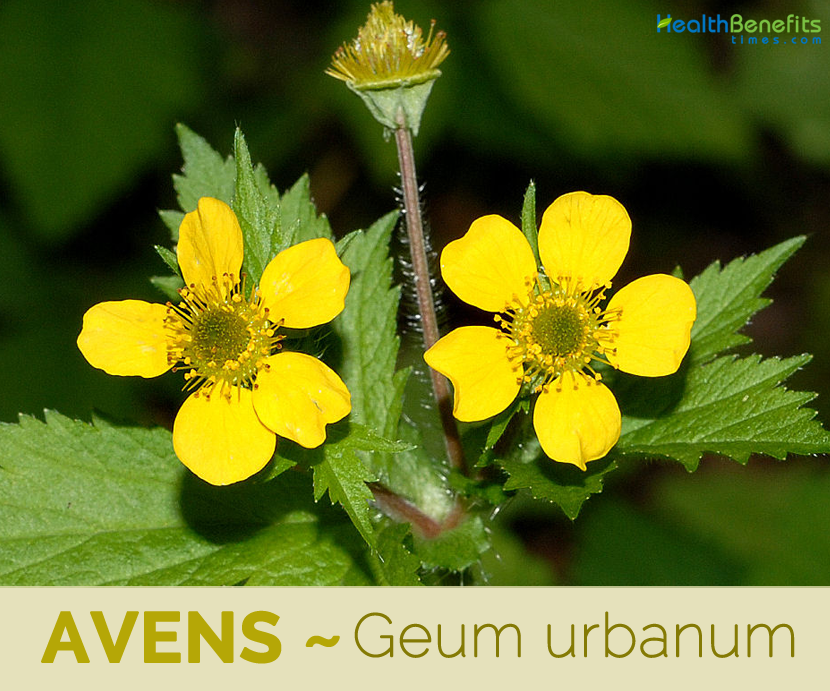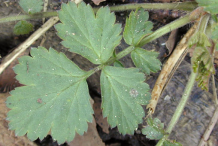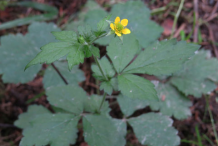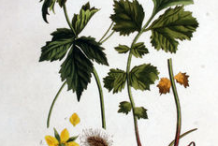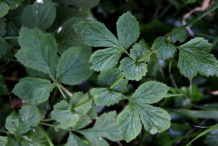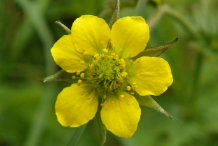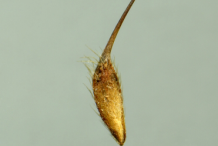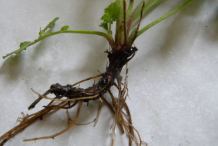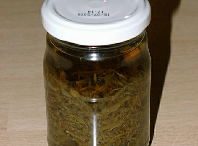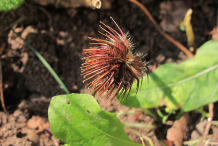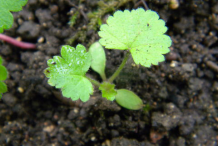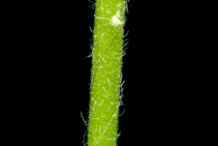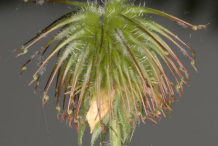Plant Description
Avens is a perennial plant that grows about 20 and 60 cm tall. The plant is found growing in forests, at the edge of forests, at hedges and near walls. Well drained and average soil in a garden will be sufficient to grow the avens. However, soil rich in humus and organic matter is normally best to grow the avens. Rhizomes are 1 to 2 inches long terminating abruptly, hard and rough with many light brown fibrous roots. Stems are thin, nearly upright, wiry, slightly branched, from 1 to 2 feet in height, of a reddish brown on one side.
Leaves
Leaves vary considerably in form, according to their position. The radical leaves are borne on long, channeled foot-stalks, and are interruptedly pinnate, as in the Silverweed the large terminal leaflet being wedge-shaped and the intermediate pairs of leaflets being very small. The upper leaves on the stem are made up of three long, narrow leaflets: those lower on the stems have the three leaflets round and full. The stem-leaves are placed alternately and have at their base two stipules (leaf-like members that in many plants occur at the junction of the base of the leaf with the stem). Those of the Avens are very large, about an inch broad and long, rounded in form and coarsely toothed and lobed. All the leaves are of a deep green color, more or less covered with spreading hairs, their margins toothed.
Flower and fruit
Flowers are rather small for the size of the plant, are on solitary, terminal stalks and about 1 – 2 cm in diameter. Corolla is composed of five roundish, spreading, yellow petals, the calyx cleft into ten segments – five large and five small – as in the Silverweed. Flowering normally takes place from May and August. Fruit is actually formed of a mass of dark crimson achenes, each terminating in an awn, the end of which is curved into a hook. Formerly, the root of some Avens was used in cooking purposes as a substitute for cloves. The Avens root (except Water Avens) smells and tastes like cloves. This helps in the identification of Avens.
Types of Avens
There are various types of Avens.
1. The Mountain Avens
Scientific name for Mountain Avens is Dryas Octopetala. It can mainly be found in the rocky lands of the Central and Eastern Arctic. It can also be found in high mountain areas of Northern Wales, Northern England, Scotland, and in Asia. They are evergreen or semi-evergreen plants. The flowers are of a creamy white color and are quite popular for rock gardens.
2. Water Avens
Scientific name for Water Avens is Geum rivale. Water Avens can mainly be found in Europe, and also in Central Asia and North America. They need moist living conditions and grow near the edges of lakes or rivers. The whole plant is used to make medicines.
3. Yellow Avens
Scientific name for this type of Avens is Geum aleppicum. They can also be found in Eastern Europe, Asia and North America. The plants can grow up to 1 m tall and has yellow flowers.
4. White Avens
Scientific name for the White Avens is Geum canadense. The plants are 1½–2½ inches tall on an average. White Avens can commonly be found in woodland borders, meadows, and Clear spaces in wooden areas. These plants can adjust well in disturbed areas.
Health Benefits of Avens
Geum urbanum herb and roots have been used in the traditional Austrian medicine internally as tea for treatment of rheumatism, gout, infections, and fever. Modern herbalists use it to treat diarrhea, heart disease, halitosis and mouth ulcers, and to prevent colic. Not all of these uses are supported by scientific evidence. Listed below are few of the health benefits of using Avens
1. Treatment for Hemorrhoids
This herb is also utilized in treatment of symptoms which lead to hemorrhoids. These are used in the ointments which are made as cure for these issues.
2. Helpful in treating a number of Digestive Issues
This herb has been known to be utilized in treating number of digestive issues such as diarrhea as well as bowel infections. Powder produced from its roots has been known to facilitate easy digestion as well as absorption of food.
3. Helps in Maintaining the Health of Liver
This herb is also known to facilitate the process of detoxification in the body. It mostly clears the liver out of its toxins and is utilized for maintaining its health.
4. Helps in Maintaining Skin Health
As mentioned before, the decoction produced from the roots of this herb is utilized for treating scars as well as wrinkles on the skin. It is one of the very common ingredients utilized in numerous beauty creams.
5. Maintain Oral Health
This herb is extensively being used in maintaining the oral health and thus tightening of gums as well as treating any oral issue being caused. It also helps in treating any throat allergy while at the same time maintaining the stomach health.
6. Acts an anti-dote for some poison
Roots of this herb is also known to act against the issues of food poisoning and are a good option to consume in case suffering from poisoning due to alkaloids as well as heavy metal poisoning.
7. Helps in Relieving Fever
Avens are one of the common herbs which have been utilized for relieving issues such as fever. It can be stored in the dried form and the can be used as first aid in numerous such conditions.
8. Helpful in Cases of Menstruation
Avens are known to be very much helpful in treating excessive vaginal discharge while at the same time relieving the symptoms of PMS.
Ayurvedic Health benefits of Avens
- Nausea: Take one cup of water and add 2 tbsp of dried Avens root. Steep for 10 minutes. Drink one cup regularly for 2-3 days.
- Diarrhea: Soak one tbsp Avens rootstock in one cup of water for half an hour. Take half cup before going to bed.
Traditional uses and benefits of Avens
- Wood avens is an astringent herb, used mainly to treat problems affecting the mouth, throat and gastro-intestinal tract.
- It tightens up soft gums, heals mouth ulcers, makes a good gargle for infections of the pharynx and larynx, and decreases irritation of the stomach and gut.
- All parts of the plant, but particularly the root, are anti-inflammatory, antiseptic, aromatic, astringent, diaphoretic, febrifuge, stomachic, styptic and tonic.
- An infusion is taken internally in the treatment of diarrhea, intestinal disorders, stomach upsets, irritable bowel syndrome and liver disorders.
- It is also applied externally as a wash to hemorrhoids, vaginal discharges etc. and to treat various skin afflictions.
- It is said to remove spots, freckles and eruptions from the face.
- Powdered root had a great reputation as a substitute for quinine in the treatment of intermittent fevers.
- Wood avens was stated to be a treatment for poison and dog bites.
- Geum urbanum herb and roots have been used in the traditional Austrian medicine internally as tea for treatment of rheumatism, gout, infections, and fever.
- Modern herbalists use it to treat diarrhea, heart disease, halitosis and mouth ulcers, and to prevent colic.
Culinary uses
- Root is used as a spice in soups, stews etc., and also as a flavoring in ale.
- It is a substitute for cloves with a hint of cinnamon in the flavor.
- Root is boiled to make a beverage.
Doses
- Dried Herb or Root = 1 to 4 gram equivalent 3 times daily.
- Infusion = 1/2 oz. of the powdered root or herb to 1 pint of boiling water, strained and taken cold.
- Decoction = Same as the infusion except that it is boiled down to half of the original liquid content. Or 1 tsp powdered root or herb with 1 cup water; 1 cup taken daily.
- Fluid Extract of the plant = 1 drachm
- Fluid extract of the root = ½ to 1 drachm
- Root Tincture = 10 drops, 3 times daily
- Powder = ¼ to ½ tsp 3 times daily.
- Simple Tincture = Pour 1 pint of 80 to 100 proof vodka or other liquor (wine can also be used) over 1 oz. of the bruised root. Allow to steep (mascerate) for 14 days and then filter through paper. 2 or 3 tsp of this tincture are taken in any watery drink or in a glass of wine for a dose.
- Compound Tincture = 1½ oz. avens root; 1 oz. each of bruised Angelica root and bruised Tormentil root; 2 oz. raisins, 2 pints French brandy. Macerate for 1 month in a warm place. The same ingredients can also be macerated in a quart of wine.
- For Diarrhea and Sore Throat: The infusion is taken strained and taken cold in wineglassful doses 3 to 4 times daily.
- As a Tonic the usual dose of the powdered herb or root is 15 to 30 grains.
Tonic tincture blend
- 1 1/2 oz. (50 g) avens root
- 1 oz. (30 g) angelica root
- 1 oz. (30 g) cinquefoil root
- 1 1/2 oz. (50 g) dried raisins
- 1 1/2 oz. (50 g) dried raisins
- 4 cups (1 liter) brandy
Combine all the ingredients in a large jar. Store away from light for 1 month. Shake every 2 or 3 days. Strain.
Take 1 oz. (25 ml) before each meal in case of a lack of appetite or a weak stomach, and 1 hour after each meal in the event of sluggish digestion or flatulence. It is used as a pick-me-up when convalescing or overcoming fatigue, and also as an anti-diarrheic.
Other Facts
- The freshly dug root has a clove-like fragrance, when dried it is used in the linen cupboard to repel moths.
- Root is used as a spice in soups and also for flavoring ale.
- In folklore, wood avens is credited with the power to drive away evil spirits, and to protect against rabid dogs and venomous snakes.
Precautions
- Avoid use during pregnancy, breast feeding.
- Excessive consumption of this herb should be avoided as it tends to cause issue such as severe stomach ache.
- It should not be taken for more than two days in a row.
References:
https://www.itis.gov/servlet/SingleRpt/SingleRpt?search_topic=TSN&search_value=24663#null
http://davesgarden.com/guides/pf/go/1829/
https://npgsweb.ars-grin.gov/gringlobal/taxonomydetail.aspx?id=17518
http://www.pfaf.org/USER/Plant.aspx?LatinName=Geum+urbanum
http://www.cabi.org/isc/datasheet/114558
http://www.floracatalana.net/geum-urbanum-l
http://www.botanical.com/botanical/mgmh/a/avens083.html
https://en.wikipedia.org/wiki/Geum_urbanum
https://plants.usda.gov/core/profile?symbol=GEUR
Comments
| Avens Quick Facts | |
|---|---|
| Name: | Avens |
| Scientific Name: | Geum urbanum |
| Origin | Central Asia and Europe |
| Shapes | Formed of a mass of dark crimson achenes, each terminating in an awn, the end of which is curved into a hook. |
| Taste | Bitter, Astringent, sweet |
| Health benefits | Treat Hemorrhoids and Relieve Fever |
| Name | Avens |
|---|---|
| Scientific Name | Geum urbanum |
| Native | Central Asia and Europe |
| Common Names | Avens, Star of the Earth, Wild Rye, Bennet, Colewort, Goldy Star, Goldy Stone, Clove Root, Old man’s whiskers, Herb bennet, Chocolate Root, City Avens, Way Bennet |
| Name in Other Languages | Catalan: Herba de les set sagnies, Herba de sant benet, Herba de set sagnies, Set sagnies Dutch: Geel nagelkruid English: Avens, Clove-root, herb bennet, town avens, Wood Avens, Bennet’s-root Finnish: Kyläkellukka French: Benoîte commune, Benoîte commune, Herbe de saint Benoît, Benoîte intermédiaire, Benoîte des villes, German: Echte Nelkenwurz, Gemeine Nelkenwurz Hindi: Jaliya Buti Italian: Cariofillata, Cariofillata commune, erba benedetta Latin: Radix Gei urbani Maori: Kohai, kopata, Kowhai Portuguese: Erva-benta, erva-de-São-Benedito Russian: Gravilat gorodskoj, гравилат городской Spanish: Cariofilada, Cariofilata, Hierba de san benito Swedish: Nejlikrot |
| Plant Growth Habit | Perennial plant |
| Growing Climate | Grows in forests, at the edge of forests, at hedges and near walls. |
| Soil | Well drained and average soil in a garden will be sufficient to grow the avens. However, soil rich in humus and organic matter is generally best to grow the avens. |
| Plant Size | 20 and 60 cm |
| Rhizome | 1 to 2 inches long terminating abruptly, hard and rough with many light brown fibrous roots |
| Stem | Thin, nearly upright, wiry stems, slightly branched, from 1 to 2 feet in height, of a reddish brown on one side |
| Leaf | Radical leaves are borne on long, channelled foot-stalks, and are interruptedly pinnate. The upper leaves on the stem are made up of three long, narrow leaflets: those lower on the stems have the three leaflets round and full. |
| Flowering Periods | May and August |
| Flower | Flowers, rather small for the size of the plant, are on solitary, terminal stalks. About 1 – 2 cm in diameter. The corolla is composed of five roundish, spreading, yellow petals, the calyx cleft into ten segments – five large and five small – as in the Silverweed |
| Fruit | Formed of a mass of dark crimson achenes, each terminating in an awn, the end of which is curved into a hook. |
| Flavor/Aroma | Root: Cloves like |
| Taste | Bitter, Astringent, sweet |
| Plant Parts Used | Aerial Parts. Uncovered roots |
| Varieties |
|
| Health Benefits |
|


